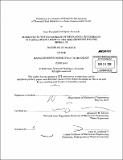Validation of a numerical model for the analysis of thermal-fluid behavior in a solar concentrator vessel
Author(s)
Rodríguez Alvarado, Juan Fernando
DownloadFull printable version (5.642Mb)
Other Contributors
Massachusetts Institute of Technology. Dept. of Mechanical Engineering.
Advisor
.
Terms of use
Metadata
Show full item recordAbstract
The need for innovation in the renewable energy sector is an ever-growing concern. With national-level disasters in the Gulf of Mexico, the necessity to begin the drive to develop effective and practical alternative energy sources becomes a more pressing concern. The CSPond project is an attempt to design a more simple solar thermal energy generation system that additionally addresses the intermittence issue. The CSPond system calls for a large container in which special salt mixtures are molten by solar thermal energy. The large container also acts as a thermal energy storage to address the intermittence issue that has held back the widespread application of solar energy systems. This thesis presents a validation analysis of a numerical simulation of a molten salt system. The simulation is part of a larger design effort to develop a viable solar thermal energy option which incorporates short to medium-term thermal storage. To validate the numerical model, a scaled version of the proposed solar vessel was used in the solar simulator built by Professor Slocum's PERG to simulate normal operation procedures. This data was then compared to the numerical simulations. This comparison found that the numerical simulation does not capture the dynamics of the temperature rise in the system, but that it does capture the Rayleigh-Taylor instabilities, characteristic of convection. Solutions to the issues identified above are proposed and analyzed. These include the consideration of several modes of thermal interactions with the environment, the optical interactions between the solar beam and the molten salt medium, modifying the boundary conditions and finally, including the temperature of all relevant thermophysical properties to better capture the convective behavior of the molten salt system.
Description
Thesis (S.B.)--Massachusetts Institute of Technology, Dept. of Mechanical Engineering, 2010. Cataloged from PDF version of thesis. Includes bibliographical references (p. 44).
Date issued
2010Department
Massachusetts Institute of Technology. Department of Mechanical EngineeringPublisher
Massachusetts Institute of Technology
Keywords
Mechanical Engineering.